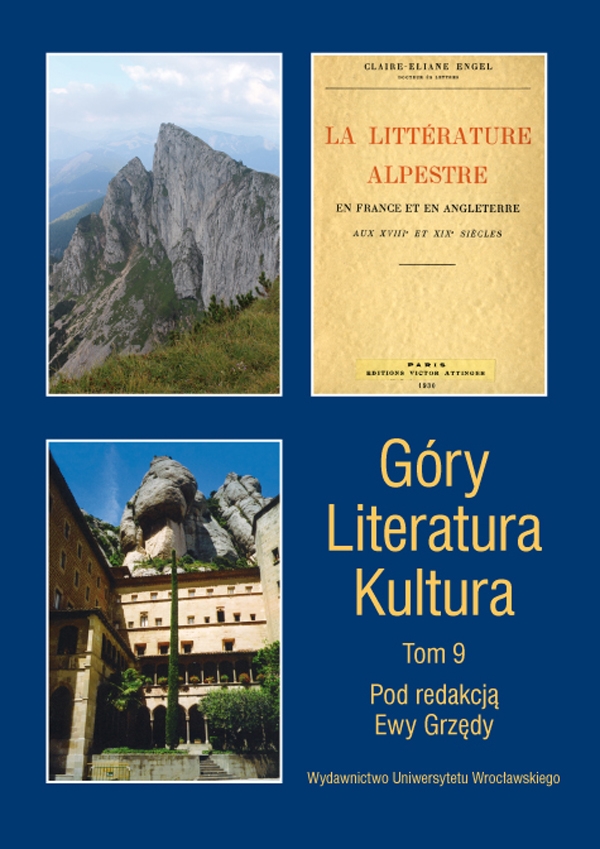

Artykuły

From Philip V of Macedonia to Horace de Saussure. From Horace to Albrecht Haller. On the history of mountain exploration
The paper deals with a long, pre-Romantic period in the history of mountain exploration from Antiquity to the first recorded ascent of Mont Blanc in 1786. The author focuses on the problem of model approach to the perception of mountains utilitarian, metaphysical and emotional, scientific, conquering, aesthetic. He attempts to provide a typology of cultural phenomena from the period preceding both the scientific exploration of the mountains and the emerging aesthetic fascination, which entered its mature phase in the Romantic era. The phenomena in question are presented on the basis of an analysis of transformations in the attitude to mountains. This is linked to the history of mountain tourism and origins of mountaineering. The author analyses the issue, distinguishing two historically changing aspects of the motivation behind mountain exploration and climbing — the first aspect is utilitarian pragmatic, while in the other mountaineering is associated with an emotional and aesthetic need to be in the mountains as an end in itself. The latter has had a huge impact on the exploration of the mountains and ways of climbing them; it also provides the background for the history of mountaineering and — more broadly — mountain tourism. When discussing the successive models of seeing and exploring the mountains, the author presents examples of how they were made sacred mountains in primitive cultures. He describes their Christianisation in the Middle Ages and demonological interpretation of the mountains related to it. In addition, he discusses the most important achievements of climbers anticipating the birth of modern mountaineering as well as characteristic facts from the history of mountain tourism. What can be considered the beginning of this great period in the history of mountain exploration was Philip V of Macedonia’s ascent in 217 of Haemus Hemus, Musala, an event described by Livy Ab urbe condida, 40, 21. The literary equivalent of the event is Horace’s ode To Taliarchus I, 9. The final date of this “initial” period must be theday of the first truly great mountaineering accomplishment: the ascent of Mont Blanc on 8 August 1786, at 18:23, by a collector of crystals from Chamonix, Jacques Balmat 1762–1834 and a doctor, Michel Paccard 1762–1834. Among the earliest medieval recorded! climbs the most important, from a competitive point of view, was the ascent by Antoine de Ville with companions of the soaring Mont Aiguille 2086.7 metres above sea level in the Dauphiné. The oldest illustration depicting a glacier is a copperplate by Joseph Plepp 1595–1642, Abbildung des Gletschers im Grindelwaldt in der Herschafft Bern. Effigies montis glacigenae in Grindelia Unterer Grindelwaldgletscher, published in Topographia Helvetiae, Rhaetiae et Valesiae 1654. Strangely enough, so far no one has noted the surprising fact that a glacier is the most important element of the landscape depicted by Benozzo Gozzoli 1420–ca 1498 in his fresco Procession of the Magi 1497–1498 at the Palazzo Medici Cappella dei Magi, Palazzo Medici-Riccardi in Florence. In the paper the author points to a curious “bipolarity” of publications from ca 1600–ca 1750 dealing with the mountains. He examines the works and achievements of e.g. Hans R. Rebmann, Athanasius Kircher SJ, Johann Scheuchzer and Elie Bertrand. The demonological aspect connected with interpretations of phenomena occurring in the mountains was absent from works by Protestant naturalists, who obviously had nothing to do with the Counter-Reformation. This “confessional aspect” in the history of mountaineering has been very lightly touched upon so far, with scholars only pointing to the fact that demonological perception of the Alps was completely alien to English tourists visiting the Alps in the second half of the 18th century in ever greater numbers. The author also discusses literary descriptions of trips to the mountains in famous literary works anticipating the emergence of mountaineering literature Dante, Petrarch, Albrecht Haller, Jean-Jacques Rousseau.